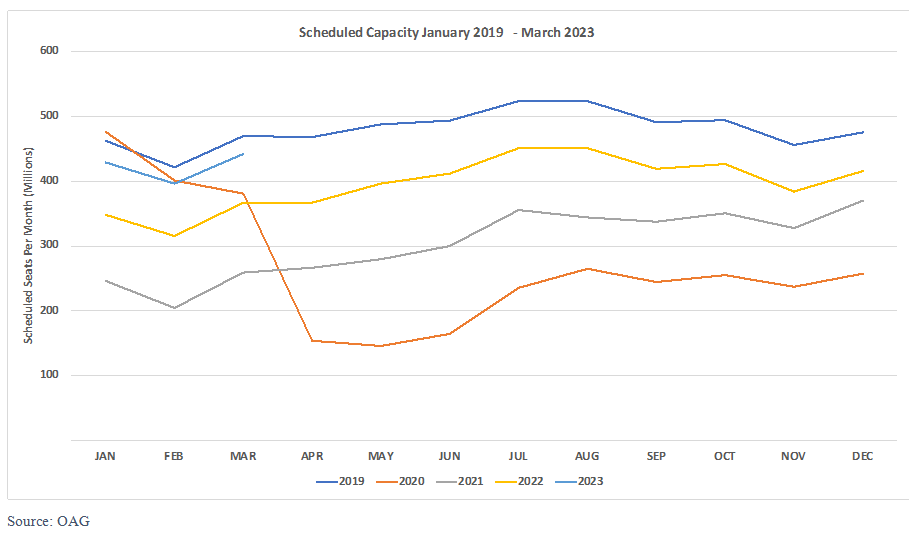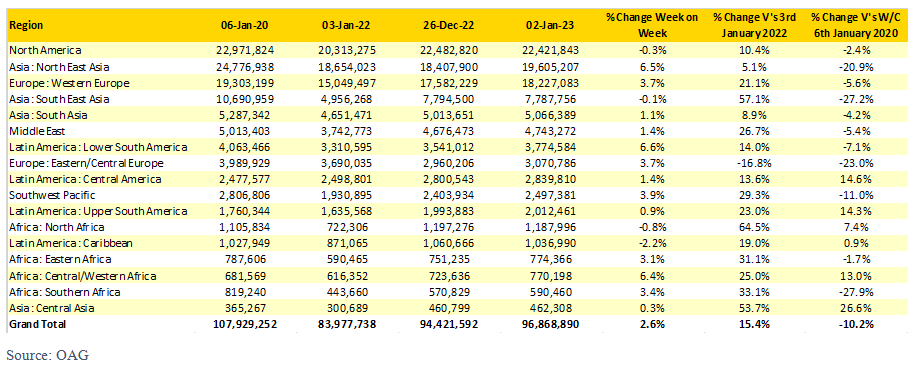
A new year is here and hopefully the travel recovery will continue through the year. There is much to reflect on in the last few weeks and of course optimism for the next twelve months, but with some tough challenges to be faced, at least in the first half of the year. But before all that, how did 2022 really finish?
Scheduled airline capacity finished as expected at 4.7 billion. However, a “cyclone bomb” and the ever-changing capacity adjustments in China throughout the year probably mean that operational capacity was slightly below that point. Still, compared to 2021 that represents an improvement of 31% much of which was loaded into the second half of the year. Some 31.2 million flights were operated, 25% more than the previous year, and not surprisingly average capacity per flight increased to 152 from 146 a year earlier. American Airlines were the largest carrier operating 248.2 million scheduled seats, the United States was the largest market and the largest city in the world was Atlanta with 54.9 million seats, although Southwest Airlines may have damaged that number last week!
Confirming that they are human, network planners appear to have been on holiday in the last few weeks with minimal changes to capacity over the next three months, which means the first quarter of this year is currently standing at 1.27 billion seats compared to 1.34 billion in 2019, it seems such a small gap to close; the reality is something else though. The announcement of China easing international travel restrictions last week has yet to be reflected in any changes in capacity and it seems unlikely that there will be any significant impact at least in Q1 as both airlines and travellers work through the logistics of restarting.
Chart 1 – Scheduled Airline Capacity

Despite being hit by a cyclone bomb, North America edges ever closer to its 2020 capacity levels and is now just 2.4% adrift of that symbolic point. Still, as we know several resource factors across the industry make that breakthrough quite unlikely this side of the summer season... and it’s only the first week of January!
With many people now back at work and the holiday period nearly over, unless your Scottish, it’s no surprise that most regions in the world are reporting week on week capacity increases; only two are reporting reductions and one of those, the Caribbean, is a reflection of the reduced volumes of leisure demand. Five of the seventeen regional markets are now producing more capacity than in 2020 while another six are within ten percentage points of that point. Three regional markets - South East Asia, North Africa and Central Asia - report significant growth on their 2022 capacity with all three at more than 50% of last year’s capacity.
Table 1 – Scheduled Capacity by Region

Although the top twenty countries remain unchanged there is some movement in positions.
Brazil has swapped positions with the United Kingdom and is now the 5th largest market in the world with 7% more capacity than last week. Similarly, Germany – which has a near 10% week-on-week increase - has switched positions with Australia. However, despite that improvement, Germany remains one of the European markets that has yet to fully recover and stands at -26% of the 2020 level; much of which is based around Lufthansa’s capacity still being some 413,000 seats a week lower than three years ago.
Collectively the top twenty country markets account for 75.5% of all capacity this week, in 2020 that share was 74.5% so little change in the distribution. However, key country markets such as Hong Kong are still a long way from recovery currently standing in 48th position compared to 27th three years ago; the easing of travel restrictions will certainly help in their recovery over the coming months. Similarly Chinese Taipei is at just half of their 2020 capacity, reopening access to China which accounted for 15% (6.8 million) and Hong Kong (11% of capacity, 5.2 million seats in 2019) will fill that missing gap considerably if sufficient resources are available.
Table 2 – Top Twenty Country Markets by Capacity





